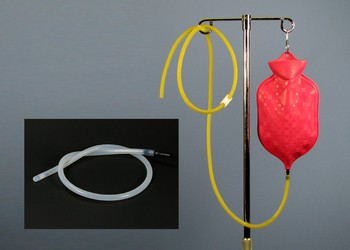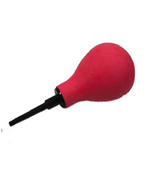Types of Enemas, which one is for you?
 There are many different types of enemas available for colon cleansing. It really comes down to your preference. Of course if you haven't tried enemas before it is best to go with the simple gravity fed travel douche enema to start.
There are many different types of enemas available for colon cleansing. It really comes down to your preference. Of course if you haven't tried enemas before it is best to go with the simple gravity fed travel douche enema to start.
There are numerous types of enemas on the market for different applications. I suggest to have at least one gravity fed enema and one for implants at home.
Prices for enema equipment vary from $10 to $300
Bag or Fountain travel enema
This is my personal favourite. Easy to handle, great for travelling, folds away and easy to clean. Holds up to 2 litres. Gravity fed system.
Easy to clean, after use, the last of the water can be emptied with the hoses still attached. This flushes out faecal material that may have back flowed into the tubing.
Very affordable . Buy Enema bag/Travel Douche
. Buy Enema bag/Travel Douche
Closed or Bottle Enema
 This is like a hot water bottle that comes complete with hook, hose, clamp, one nozzle and a vinyl carrying case.
This is like a hot water bottle that comes complete with hook, hose, clamp, one nozzle and a vinyl carrying case.
It comes in many different styles and colours. It is used in the same fashion than the Bag Enema. Hot water bottles require more effort in cleaning.

Click Here to buy a closed system, water bottle enema kit
Higginson Enema
Great for an enema where the body is submerged in water (eg. ocean or river) because you pump it in. Otherwise very awkward to use (you have to be extremely careful not to pump air into your system).

Click Here to buy a Higginson Syringe
Directions for Use:
* Remove tip and flush bulb with water before first use. Replace tip.
- * Fill bulb by putting the end without the tip in a bucket with water.
- * Try to clamp it to the bucket, so it can't emerge out of the water in which case you would pump air into you instead of water.
- * Attach enema pipe and lubricate tip with lubricating jelly.
- * Expel air from tip by squeezing bulb until water comes out the tip.
- * Gently insert enema tip into rectum. If resistance occurs, pause for a few seconds and gently advance.
- * Squeeze solution slowly and gently pausing momentarily.
Bulb Enema
These small Bulb enemas are great for a quick solution or for children as you can administer safely a small amount. Good for Implants.
They are also called Adult Enema Syringe - and come in different sizes. The two pieces are easy to clean
Directions for Use:
* Remove tip and flush bulb with water before first use. Replace tip.
- * Fill bulb with recommended enema solution.
- * Attach enema pipe and lubricate tip with lubricating jelly.
- * Expel air from tip by squeezing bulb (don't let go now otherwise you suck air back in).
- * Gently insert enema pipe into rectum. If resistance occurs, pause for a few seconds and gently advance.
- * Squeeze solution slowly and gently pausing momentarily.
Try a cold water bulb syringe enema to relieve constipation, retain water for 1 minute then expel, use this for a colon lacking tone. If the colon is spastic try a warm water bulb syringe enema.
Implant Equipment
 The easies way to administer an Implant is with an Implant kit (60ml Syringe and a rectal tube). This way you make sure that you don't take too much and it is easier to clean than if you use a large Enema Kit. This Kit is excellent for Ayurvedic Oil Enemas.
The easies way to administer an Implant is with an Implant kit (60ml Syringe and a rectal tube). This way you make sure that you don't take too much and it is easier to clean than if you use a large Enema Kit. This Kit is excellent for Ayurvedic Oil Enemas.
Care and Cleaning of Enema Equipment
The standards of cleanliness of enema bags and colonic buckets are most important. Shared bags can mean shared germs. Unclean nozzles and tubing can mean the growth of bacteria cultures.
The bag or bucket once used should not return to storage until it is clean and dry. Wet bags, left wet, can crack and deteriorate quickly. Bags or tubing put away wet can produce mildew.
If the bag is rinsed and dried well and used by only one person, any bacteria or pathogen introduced into the colon will probably already be present or they will already have developed resistance to it.
Dry bags and tubes don't mildew. Dry bags and tubes are filled with oxygen. Most disease pathogens are anaerobic. That means they don't like oxygen and die when dried out in open air. It is very important to clean and dry enema bags, colonic buckets, tubing and nozzles after use.
Fecal material reaching the bag is possible and common. This can be prevented in two ways. One, hang the bag high enough (at least 1m) to keep the pressure, so that no water can go into the bag. The second, is to stop the flow before the bag is completely empty and close the clamp before lowering the bag to prevent back flow.
The tubing and hose are another matter. Normal surges in pressure in the rectum during the enema make it almost a certainty that the tubing will have some back flow of fecal material into the tubing.
- The first thing to do is wash the bag or bucket with soap and water.
- Use a bacterial soap such as Betadine surgical scrub or something that kills germs.
- Let the bag, bucket, tubing and nozzle soak in this solution for several minutes.
- Then remove and rinse with plain tap water.
- You can sterilize the reservoir, tip, lid, hose, and tubing by immersing in water using bleach (approximately 1 capful per 3.5 litre of water) or using a preferred sanitizing solution with water.
- Rinse the equipment well, as you don't want to put bleach into your system next time.
- You can use a little baking soda in the rinse water. On drying it leaves an alkaline coating on the inside of the bag and tubing. This also helps prevent the growth of bacteria, or mildew, and is not toxic as many other bactericidal additives are.
